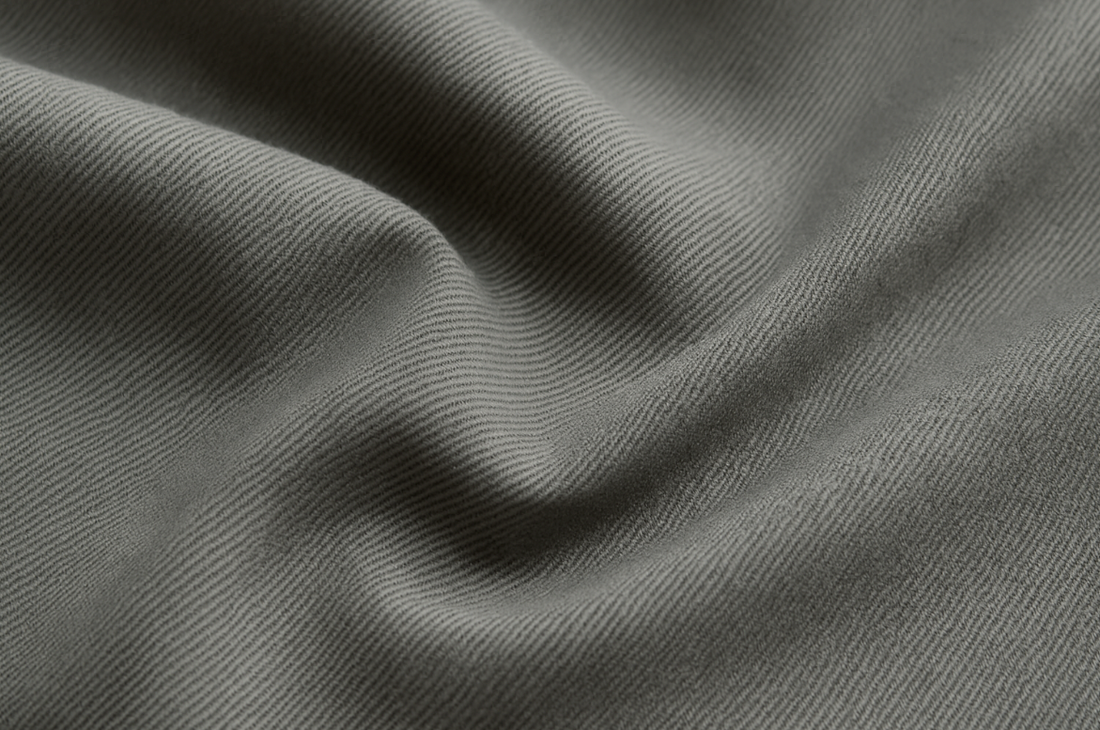
Twill Fabric: The Diagonal Weave That Changed the Way We Dress
Twill fabric is everywhere—your favorite pair of jeans, that sharp blazer, even your trench coat.
But what makes twill so special? Why did we invent it in the first place? And what problems does it solve that plain weave fabrics just couldn’t?
By the end of this article, you’ll understand:
- What twill fabric is and how it’s woven
- Why designers and brands use twill to solve structural issues
- When not to use it—and how to prevent common problems like knee bulges
- How twill compares to plain and satin weave in durability, drape, and wrinkle resistance
What Is Twill Fabric?

Twill fabric is defined by its signature diagonal weave—created when the weft thread passes over one or more warp threads and then under two or more. This staggered pattern shifts row by row, producing a recognizable line or “wale.”
Unlike plain weave, which looks and feels flat, twill has depth, direction, and texture. It’s denser, more durable, and often drapes better.
Why Did Humans Invent Twill?
Plain weave fabrics are simple and fast to make—but they’re stiff, wrinkle-prone, and can tear under strain. Designers needed a fabric that could bend without breaking, resist wear, and offer better structure.
Twill answered that call with:
- Natural elasticity from the angled weave
- Improved wrinkle resistance
- Greater durability in high-friction zones
- Better drape for tailoring
No wonder it’s the default for denim, chinos, workwear, and outerwear.
Why Twill Isn’t for Everything
That said, twill isn’t perfect. Its heavier weight and structured form can work against you in certain garments:
- Not ideal for breezy summer tops or lightweight dresses
- Can feel too stiff for relaxed, flowing silhouettes
- Doesn’t breathe as well as looser weaves like gauze or voile
In pants, a common issue is “knee bulge”—especially with tight or skinny fits. As twill fabric bends at the knee repeatedly, it forms a memory crease that holds the shape. It’s not about poor fabric quality—it’s a structural side effect.
Solution:
Choose twill fabrics with a touch of stretch fiber (like elastane) and pre-shrunk treatment. These reduce stress points and allow the fabric to rebound after motion.
How Is Twill Woven?
Twill is made by shifting each weft row diagonally. The most common type is 2/1 or 3/1 twill, where the weft goes over two or three warp threads before going under one.
This simple variation dramatically changes the fabric:
- More threads per inch = stronger fabric
- Oblique structure = smoother drape and better stretch
Compared to other weaves:
| Weave Type | Look & Feel | Strength | Wrinkle Resistance | Drape | Yarn Demand |
|---|---|---|---|---|---|
| Plain | Flat, tight | Moderate | Poor | Rigid | Low |
| Twill | Diagonal ribs | High | Good | Balanced | Medium |
| Satin | Glossy, smooth | Medium | Excellent | Flowing | High |
Twill sits comfortably in the middle—more durable than satin, more elegant than plain weave.
Does Twill Increase Production Cost?
In short, yes—but not dramatically. Twill weave requires more passes on the loom and often consumes more yarn due to the overlap. There’s also more fabric loss when cutting diagonally patterned fabrics to match the grain correctly.
But for designers, that cost is often worth it. Twill brings:
- A professional finish
- Shape retention
- And a premium feel that lasts
The Bottom Line
Twill fabric is a workhorse with elegance. It fills the gap between structure and flexibility, performance and polish. While it’s not right for every piece, when used correctly, it elevates your garment’s form and function.
Looking to experiment with twill in your next design?
Use our Fabric Calculator to estimate yardage accurately, or visit our Studio if you'd like to develop samples or prototypes. We’re happy to help.
